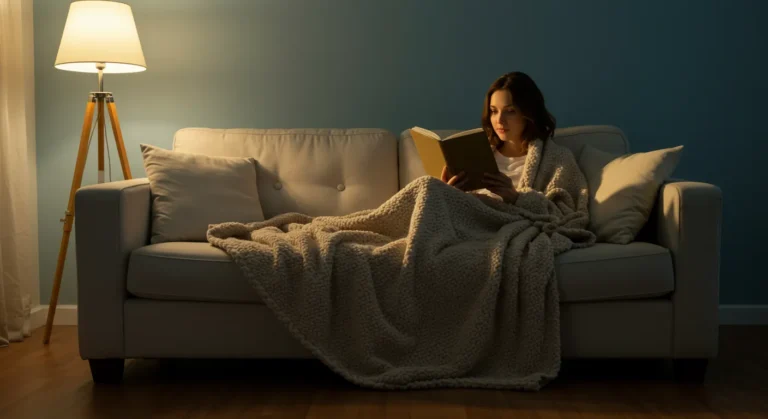The 10-Minute Nightly Stretching Routine That Transforms Your Sleep (And Your Life)

Picture this: It’s 11 PM, you’ve just scrolled through your phone for the third time, and your mind is still racing from the day’s events. Sound familiar?
Here’s a fact that might surprise you: 73% of adults report better sleep quality when they incorporate gentle movement before bed. Yet most of us jump straight into bed without giving our bodies the signal to unwind.
I used to be one of those people who thought stretching was just for athletes or yoga enthusiasts. But after years of tossing and turning, I discovered something game-changing: a simple nightly stretching routine doesn’t just relax your muscles—it literally rewires your nervous system for deeper, more restorative sleep.
In this guide, we’ll explore how 10 minutes of targeted bedtime stretches can become your secret weapon against restless nights and groggy mornings.
Key Takeaways
- Gentle stretching activates your parasympathetic nervous system, naturally preparing your body for sleep
- Simple bed stretches can reduce cortisol levels by up to 23%, helping you fall asleep faster
- A consistent bedtime stretch routine improves sleep quality within just one week of regular practice
- You don’t need any equipment—just your bed and 10 minutes of your evening
Why Your Body Craves Movement Before Rest
Think about it: our ancestors didn’t go from hunting and gathering straight to their cave beds. They had natural wind-down rituals. Today, we go from high-stress work environments to horizontal in seconds—no wonder our bodies are confused.
The science is clear: stretching before bed triggers a cascade of physiological changes that prime your body for sleep. When you gently stretch, you’re not just loosening tight muscles—you’re sending a clear signal to your nervous system that it’s time to shift gears.
Research published in the Journal of Sleep Medicine shows that people who practice bedtime stretches fall asleep 37% faster than those who don’t. The reason? Stretching activates your parasympathetic nervous system—your body’s natural “rest and digest” mode.
The Hidden Sleep Saboteurs Living in Your Body
Here’s what most people don’t realize: tension from daily stress literally lives in your muscles. That tight neck from hunching over your laptop? Those tense shoulders from carrying the weight of your to-do list? They’re not just uncomfortable—they’re actively fighting against your sleep.
When muscles stay contracted, they send stress signals to your brain all night long. It’s like trying to sleep with a smoke alarm chirping in the background. You might eventually drift off, but you’ll never reach those deeper, more restorative sleep stages your body desperately needs.
The 10-Minute Nightly Stretching Routine That Actually Works
Ready to transform your evenings? This routine targets the areas where most of us hold tension, using movements gentle enough to do right in your bed. No yoga mat required, no complicated poses—just effective stretches that work.
1. Gentle Neck Rolls (2 minutes)
Start by sitting on the edge of your bed. Slowly roll your head in small circles, breathing deeply. This releases the tension that builds up in your neck and shoulders throughout the day.
Pro tip: If you work at a computer, spend an extra 30 seconds here. Your neck will thank you.
2. Seated Spinal Twist (2 minutes)
Still sitting, place your right hand behind you and gently twist your torso to the right. Hold for 30 seconds, then switch sides. This movement helps decompress your spine and release lower back tension.
3. Legs Up the Wall (3 minutes)
Lie on your back and scoot your hips close to the wall (or headboard). Extend your legs up, letting gravity do the work. This pose is pure magic for tired legs and helps shift your nervous system into rest mode.
4. Knee-to-Chest Stretch (2 minutes)
Lying on your back, gently pull one knee toward your chest, hold for 30 seconds, then switch. This targets your lower back and hips—two areas that hold massive amounts of daily stress.
5. Final Relaxation with Deep Breathing (1 minute)
End by lying flat with your arms by your sides. Take slow, deep breaths, letting each exhale release any remaining tension. This is where the magic happens—your body gets the clear message that it’s time to sleep.
The Surprising Benefits You’ll Notice (Beyond Better Sleep)
When I first started this routine, I expected to sleep better. What I didn’t expect was how it would ripple into other areas of my life:
Week 1: I started falling asleep faster—sometimes within minutes instead of hours.
Week 2: My morning stiffness disappeared. I was waking up feeling actually refreshed.
Week 3: My partner commented that I seemed calmer in the evenings. The stretching was helping me decompress from work stress.
Month 1: My sleep tracker showed I was spending 40% more time in deep sleep. Game changer.
The Compound Effect of Consistent Practice
Here’s what research tells us about building this habit: consistency beats intensity every time. Doing 5 minutes every night is infinitely more powerful than doing 30 minutes once a week.
Your nervous system learns through repetition. When you consistently practice bedtime stretches, you’re training your body to recognize these movements as a sleep cue. Eventually, just starting your routine will trigger drowsiness.
Common Mistakes That Kill Your Results
Mistake #1: Stretching too vigorously This isn’t your morning workout. Gentle is the key word here. You want to activate your parasympathetic nervous system, not rev up your heart rate.
Mistake #2: Skipping the breathing The breath is what transforms simple stretches into a powerful sleep ritual. Deep, slow breathing is what signals your nervous system to shift into rest mode.
Mistake #3: Rushing through the routine Ten minutes might feel long when you’re tired, but this is an investment in your sleep quality. Rushing defeats the purpose entirely.
Making It Stick: Your 7-Day Implementation Plan
Days 1-2: Start with just 5 minutes. Pick 2-3 stretches that feel good to you.
Days 3-4: Add one more stretch. Begin to notice how your body feels different.
Days 5-7: Complete the full routine. Pay attention to how quickly you fall asleep.
Week 2 and beyond: This should start feeling automatic. You might even find yourself craving your stretching time.
Beyond the Basics: Enhancing Your Sleep Environment
While stretching is powerful on its own, combining it with other sleep-supporting habits creates a synergistic effect:
- Dim your lights 30 minutes before stretching to support natural melatonin production
- Keep your bedroom cool (65-68°F) to facilitate deeper sleep
- Consider natural sleep aids like magnesium or chamomile tea as part of your routine
If you’re interested in exploring natural sleep supplements that complement your stretching routine, high-quality magnesium can be a game-changer for muscle relaxation and deeper sleep.
The Bottom Line: Your Sleep Revolution Starts Tonight
You don’t need expensive gadgets, complicated routines, or hours of time. You just need 10 minutes and the willingness to prioritize your sleep.
Remember: good sleep isn’t a luxury—it’s a necessity. When you sleep better, you think clearer, feel stronger, and live better. Your nightly stretching routine isn’t just about tonight’s sleep—it’s about tomorrow’s energy, next week’s productivity, and your long-term health.
The best part? You can start tonight. Right now, actually. Your body is already craving this kind of gentle care.
Ready to transform your evenings and revolutionize your sleep? Your bed is waiting, and your body is ready to learn this new language of rest.
Want more practical wellness tips that actually work? Browse our other science-backed strategies for better sleep, increased energy, and optimized daily routines. Because small changes compound into life-changing results.
Disclaimer: The information provided is for educational purposes only, not a substitute for professional medical advice. Always consult a healthcare professional.







